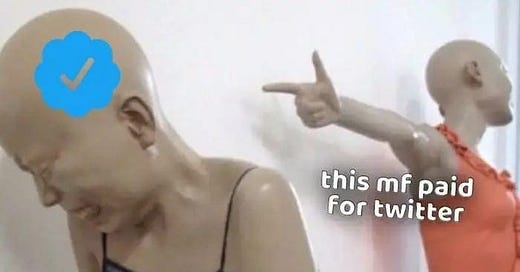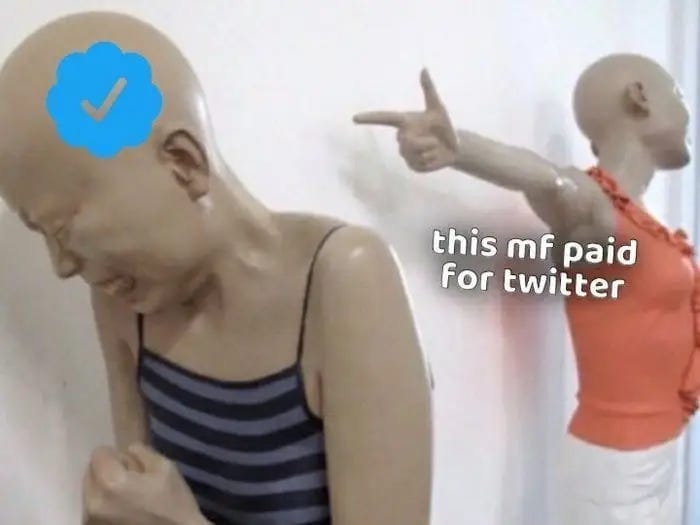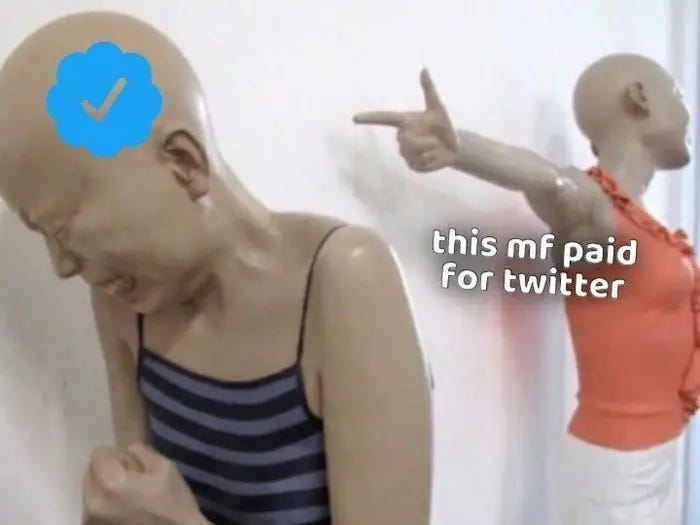Twitter's moment of truth has arrived
As Elon Musk removes the legacy blue checks, he needs more people to subscribe. It isn't happening.
When Elon Musk took over Twitter on October 27, he was determined to transform the meaning of the blue checkmark. In particular, he was incensed it was given to journalists — people he’s increasingly turned against as coverage of him has become more critical — because he felt it gave them an exclusive status on the platform they didn’t deserve.
His solution was simple: blue checks would become a paid feature, rolled into a revamped Twitter Blue subscription service, to end what he called the existing “lords & peasants system.” He replaced it with an approach he claimed would be more democratic because anyone could buy their way in — as long as they had $8 a month to drop on a social media platform.
After the absolute shambles of the initial rollout in November that led to a wave of impersonations and consequences for companies that previously saw Twitter as a trusted partner, Musk is about to follow through on the second stage of the plan. Now that people can buy a check mark, the “legacy” blue checks need to go away.
According to a recent tweet, all the celebrities, journalists, and other notable people and organizations who were granted a blue check under the previous regime have until April 1 to start paying or it will be removed. Their tweets will then stop being promoted in the algorithmic “For You” feed on April 15, and any Twitter user not paying their $8 will apparently be barred from voting in polls.
The next few weeks will be a pivotal moment for what Musk has been calling Twitter 2.0. If people don’t sign up when the legacy blue checks are removed, it’s hard to see how the Blue subscription can become the source of revenue that Musk desperately needs it to become. And since that’s unlikely to happen, it’s even more difficult to imagine much of a future for the platform.
The Numbers Aren’t Looking Good
When Musk bought Twitter, he took on $13 billion in debt to fund the acquisition, on top of the personal funds and investor contributions he used to cobble together the $44 billion purchase price. As a result, the company has massive interest payments to make every quarter, adding up to an estimated $1.5 billion a year. That’s why Musk has been firing thousands of workers, stiffing suppliers, and not even paying the rent on Twitter’s buildings as he forces employees back to the office.
But his actions have made it harder to make those payments. Before Musk took over, Twitter was getting 90% of its revenue from advertising, yet he fired many of the employees handling those relationships then made a series of decisions that lost the trust of advertisers, from the botched paid verification launch to the unbanning of far-right and other hateful accounts.
In November 2022, major ad agencies like Omnicom and IPG recommended the global brands they represent pause their spending on the platform. By early January, it was estimated that more than half of Twitter’s top 1,000 advertisers from September 2022 had done just that, cutting deeply into Twitter’s revenue. In September and October of 2022, the company’s top 10 advertisers spent $71 million on Twitter ads, but that has plummeted 89% to $7.6 million in the past two months and revenue from Blue subscriptions isn’t anywhere near enough to fill that hole.
As of mid-January, only about 180,000 people in the United States were paying for Twitter Blue, according to The Information, or about 0.2% of monthly active users, with an estimated global total of 290,000 paying users generating $28 million in annual revenue. To compare, Twitter pulled in $5.1 billion in revenue in 2021, while Musk previously projected $3 billion in 2023.
Since those figures were released, Twitter Blue has opened to users in more countries around the world, but still only has an estimated 445,000 to 475,000 paying users — nowhere near what Musk needs — and at most only about 5% of “legacy” verified users appear to be converting to paid before their blue checks are removed. Some of those people have even dropped their Blue subscriptions in recent months, presumably not because they can’t pay; they just refuse to give their money to a platform owned by an increasingly divisive and openly right-wing billionaire.
Musk is also banking on organizations signing up for a gold checkmark that will cost $1,000 a month, plus an additional $50 a month for each employee they want to have verified, and other users to pay for access to the company’s API at a “basic” rate of $100 a month or an enterprise rate which reportedly starts at $42,000 a month. Instead, many news organizations have already said they won’t pay for verification and many accounts using the API have said they’ll simply shut down. Nothing seems to be working out as Musk plans, which tells us he doesn’t have a very good grasp of how Twitter actually works.
A Series of Poor Decisions
Since taking over, it’s become clear that Musk’s plans for Twitter were driven by personal grievances, but also by the misconceptions (or outright deceptions) of right-wing users as they pointed out problems with the platform. Their issues are often not rooted in reality, but designed to force social media companies — like traditional media companies before them — to make decisions that further boost the prominence of right-wing views, regardless of whether or not they’re really being silenced or suppressed. It’s no surprise Musk can’t please them.
But his decisions also show a deeper problem. Musk has a long history of entering industries he doesn’t have much experience in and acting as though he’s an expert. In some cases, he’s been able to get by because he took the initiative to do some research or had real experts whose work he could take credit for. That’s not the case at Twitter, where he gutted the company’s expertise soon after taking over, brought in advisers from unrelated companies, and simply tried to revive ideas that failed for him in the past.
Now the platform is failing, with usage in the United States falling almost 9% in the few months after he took over. Not only does he not seem to know how to respond, but he refuses to believe his decisions are part of the problem. In February, Platformer reported he was furious about declining engagement on his tweets, and fired a worker for suggesting public interest was waning months after his acquisition closed. Instead of looking for real solutions, he forced his remaining engineers to build a special system to boost his tweets. That might make him happy in the short term, but it won’t fix Twitter’s deeper problems.
As Musk changes the platform, he’s also killing what most people enjoyed about Twitter. A growing number of interesting users are leaving or posting less as Musk opens the floodgates to white nationalists, spammers, and other disruptive forces. At the same time, he keeps adding poorly considered features that show he doesn’t understand how users engage with Twitter, all while erecting a paywall that further degrades the experience.
It’s no wonder that so few people are compelled to pay for a blue check when making it a paid feature also took away the very reason to want one in the first place. For many users, it was never really something to be coveted, but a symbol of trust. It was a quick way of knowing an account was authentic, and it certainly doesn’t have that connotation anymore. But even for those who were obsessed with it as a status symbol, it’s also lost that quality because anyone can buy one for $8.
In fact, if anything having a blue check is already starting to signal that you can’t be trusted — and that will especially be the case after April 1. Being identified as a Blue subscriber already results in a stream of replies filled with mocking memes if one of their tweets goes viral, and many users are now saying they’ll block subscribers after the “legacy” checks go away. After all the fuss over letting people buy blue checks, Twitter is reportedly working on an option to hide them. (The long tweets will still give them away.)
But blocking Blue subscribers is only going to get easier when Musk turns the “For You” feed into a list of tweets almost exclusively from paying users on April 15. Recent research shows that half of all Blue subscribers have fewer than 1,000 followers, suggesting the quality of the tweets in that feed probably aren’t going to be very high. Who wants a feed filled with white nationalists, hustle bros, and Tesla fanboys? I can’t imagine it’s many people, and will result in a series of swelling block lists across Twitter or a further shift to the “Following” tab. Musk needs people to sign up in significant numbers, but that seems highly unlikely.
The Future Looks Grim
When all these details are added up, it’s hard not to conclude that Twitter’s days are numbered. That doesn’t mean that Twitter is going to go offline, but as we’ve seen many times in the past, social media platforms rise and fall. Twitter is definitely sinking and more people will continue to jump ship. At this point, with such inept leadership, it also seems hard to imagine they can ever save it, especially if Musk doesn’t get out of the way and lets someone who knows what they’re doing take over.
While many celebrate the demise of Twitter, it’s also a sad moment. For over decade, it’s been a place where people came together and found community. I’ve personally made friends through the platform and I wonder if I’d have the writing career I do without it. Even as potential alternatives have sprung up or gained traction in recent months, it seems hard to imagine any of them really taking the place Twitter once held — and all the popular platforms are pushing people away from text and into video.
But Twitter’s death needs to be worth it. Elon Musk has benefited for two decades from the myth he’s a genius inventor building a better future for all of humanity. There was always plenty of evidence to the contrary that was too often ignored, but seeing him burn Twitter to the ground is making many more people aware of the reality of who he is and has always been.
When Twitter goes, it needs to take Elon Musk with it.






